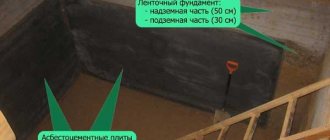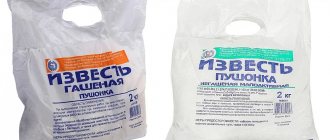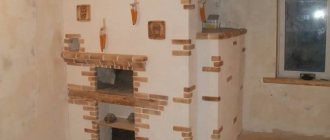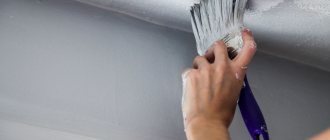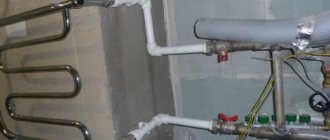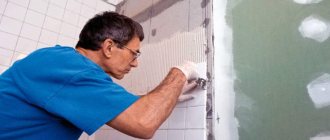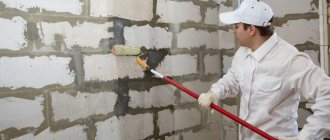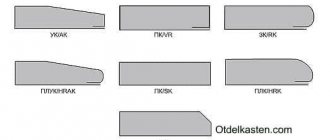The correct disinfection and drying procedure is the key to healthy vegetables that will be stored throughout the winter without problems, rotting or fungal damage. Let's look at all the manipulations - standard and not so standard - that experienced gardeners resort to.
First we dry the basement
About a month and a half before the harvest is stored in the cellar, they begin to prepare the room. The first stage of this process is drying. What is it for? Firstly, if constant condensation accumulates in the room, dripping from the ceiling, and streams running along the walls, fungus and mold will certainly appear in the cellar as a result of high humidity. Secondly, in a damp room, vegetables quickly deteriorate and are affected by diseases. Thirdly, all pantry equipment - wooden panels, pallets, shelves - quickly rots. For these simple reasons, the cellar is ventilated and dried every year. All hatches, doors, windows, if any, open. Pallets, panels, shelves and other equipment are taken outside to dry. Rotten boards are replaced. If the material is not badly damaged, you can simply scrape off the rotten wood and treat it with a disinfectant.
The earthen floor is dried as follows: the top layer, approximately 5 cm, is removed and taken out. The resulting depression is filled with dry sand, preferably river sand, with a coarse fraction. Thus, in winter, moisture will be absorbed into the material, fungus or insects will not grow, since they do not like sand as a habitat. You can add lime to it, it absorbs moisture well.
If the basement is so damp that normal ventilation does not help, you will have to resort to the old, proven drying method that our grandmothers used. A bucket of smoldering charcoals is lowered into the cellar and kept there until they go out. The procedure is repeated several times. The use of electric heating appliances in basements is prohibited for safety reasons.
Basement equipment should be completely replaced once every three to four years. This also applies to wooden partitions, pallets, shelves, and other auxiliary elements. Constant ventilation and disinfection, of course, prolongs the life of the tree, but not for long. Therefore, replacement is inevitable if you want to have healthy vegetables all year round.
Having dried the cellar, we proceed to the next stage of preparing the room for storing vegetables and preparations - disinfection.
Cellar disinfection
Often you can see whitish formations on the walls, ceiling and shelves - these are fungal spores or, in other words, mold. Such proximity to vegetables is unacceptable. This needs to be fought, and very actively. Scrape mildew from walls, ceilings, and shelves. Then treat the surfaces with a strong solution of potassium permanganate; it should be red, not pink. If the room is severely damaged, potassium permanganate alone will not do. Couples of quicklime will be used. This remedy is very effective - mold goes away, pests die and even rodents scatter. The procedure is carried out as follows:
1. For 5 m2 take 1.5 kg of quicklime. Place it in a bucket or barrel, which will then need to be lowered into the basement.
2. Fill the lime with water and quickly lower it into the cellar.
3. Close the room so that a sealed “box” is formed; the vapors should not immediately evaporate. The ventilation pipe is also covered.
4. Wear a mask when working.
5. Leave the lime bucket or barrel for two days.
6. Then ventilate the cellar and repeat the procedure in a week.
Instead of quicklime, you can use a sulfur block. True, all precautions must be taken here. Many gardeners claim that smoke “does not pick up” mold in cracks and corners. Lime works better. Well, one or another option is suitable for each room. You need to try and figure out the best way. There is another, very simple and reliable method - whitewashing the walls and ceiling. But it is suitable for dry rooms where there is almost no mold and mildew.
There remains the last stage of preparing the cellar for winter - the fight against rodents who so love to feast on vegetables.
We drive out mice and rats
In fact, it is possible to drive away rodents. The main thing is to approach this process wisely. Modern devices that emit ultrasound certainly help. But not everyone can afford to install appliances in their basements. And here nature itself comes to the rescue. She has a whole bunch of useful plants to fight mice and rats. Rodents have a very sensitive olfactory sensory system. They can't stand it:
By placing these plants in the cellar, you will keep pests away from your supplies for a long time. Moreover, mice are more afraid of elderberry, and rats are more afraid of black root and wild rosemary. Plants are planted along with the first harvest.
So, we have dealt with all the stages of preparing the cellar to receive a new harvest - drying, disinfection and rodent control. Finally, let us mention one more useful tip for storing potatoes, carrots, beets and other vegetables. Be sure to sprinkle the harvested crop with “fluff” - this is rotted lime, which resembles flour. It turns into such a substance after lying in the open air for a long time. At the same time, lime does not lose its disinfecting properties. Flour all the vegetables with lime flour, no need to worry about too much. Nothing will happen to the harvest; the fluff does not affect its “usefulness”. This way it will lie safe and sound all winter.
How to whitewash a cellar. Whitewashing a cellar or basement
When storing vegetables in a basement or cellar, conditions arise that are favorable for the development of putrefactive bacteria, mold fungi and insects that get there from the garden.
Therefore, every year before planting a new crop in the basement, it is necessary to disinfect it. Whitewashing the cellar and basement is necessary to prevent the development of fungi and bacteria.
The most affordable, safe and proven method is whitewashing the basement with lime.
Fresh slaked lime is a caustic alkali, a solution of which is used to disinfect any surfaces in the basement.
How to whitewash a basement?
Lime solutions for cellar disinfection can be prepared in different ways:
- The simplest whitewash solution is prepared from 1 part lime paste mixed with 4-5 parts water. With normal consistency of lime milk, a stick immersed in it should be covered with a thin layer of solution, which slowly drains from it.
- 1 part fluff is mixed with 1.5 parts water. The resulting mixture is filtered through a sieve or cheesecloth to remove lumps.
- To increase the disinfecting properties of lime milk, add copper or iron sulfate to the solution in an amount of 0.1 part (10%) of the volume of liquid prepared according to recipe 1 or 2.
To ensure the stability of the lime coating, add drying oil or table salt (100 g per 10 l) to the solution.
Before whitewashing, the remains of vegetables, garbage, damaged boxes and collapsible racks are removed from the cellar. The surfaces of the ceiling and walls must be cleaned of dust and dirt, and cracks in the walls must be repaired with lime paste. Moisten surfaces with water.
The device of a homemade spray gun.
You can apply the lime solution using natural bristle brushes, sponge brushes, or a paint roller. For more economical consumption of the solution, use a spray gun. The applied layer of lime is slightly dried, after which the treatment is repeated. A layer of fluff 0.5-1 cm thick is poured onto the floor of the basement or cellar. Such measures can completely get rid of fungi and rot in the cellar.
To destroy insects and their larvae in the basement, they are treated with lime vapors released when it is slaked. Lumps of quicklime at the rate of 3 kg per 10 cubic meters of room are placed in a container, filled with a large amount of water and left the basement, closing the door tightly. After 2-3 days, the room is thoroughly ventilated.
Return to contents
How to slak lime correctly?
Slaking is the interaction of lime with water, during which the liquid is strongly heated and vapors and carbon dioxide are released. To prepare lime paste, take 1 part quicklime, place it in a container and add 3 parts cold water, stirring with a long stick. After 30-40 minutes, the process ends; a mass resembling a thin dough remains in the container. In this form, lime is used for whitewashing or stored, tightly closed with a lid, for 1-2 years.
To prepare fluff, add 1 part lime to 1 part water. As a result of heating, the water completely evaporates, and a crumbly fine powder is formed in the container.
During the reaction, the liquid begins to boil violently and splash, so precautions must be taken:
- protect your hands from contact with hot caustic alkali with rubber gloves;
- to avoid damage to clothes, wear overalls or a robe;
- Protect your eyes from exposure to vapors and splashes with protective glasses;
- wear a respirator or gauze bandage to avoid inhaling the vapors released during extinguishing.
It is necessary to disinfect the basement or cellar in advance. Lime treatment must be completely completed 1 month before storing a new crop of vegetables.
Lime from fungus. If there is a small amount of mold or mildew
In this case, the easiest way is to use folk remedies that are least likely to harm a person. But sometimes you have to use more powerful compounds.
Fire treatment
In this case, you can use a blowtorch or other available means. This is a mechanical method of mold removal that will help solve the problem only at the initial stage. After burning off the mold, it is imperative to solve the problems that caused the appearance of dangerous particles.
Vinegar
In 80% of cases, this remedy helps get rid of mold if the affected area is small. If small dots appear on the walls or ceiling, you can “cauterize” them with ordinary table vinegar applied to a clean sponge. You can also dilute it in water in equal parts and rinse the affected surfaces thoroughly.
If the basement is seriously infested, you can prepare a more powerful remedy. For this:
- Pour half a glass of water into a container.
- Add 50 ml of table vinegar and the same amount of hydrogen peroxide.
- Add 25 ml of boric acid.
- Slowly mix all the ingredients and heat the resulting mixture over low heat to 50-70 degrees.
- Immediately, while the mixture is warm, apply it to the affected areas of the concrete walls and ceiling.
- We wait 15 minutes.
- Clean the surface with an old brush. We throw it away.
Although this is a relatively complex recipe, it pays off.
Hydrogen peroxide
In this case, we will need regular 3 percent hydrogen peroxide, which is sold at any pharmacy. Since it is already very diluted, there is no need to dissolve the liquid in water. It is enough to apply peroxide to a soft sponge and walk it over the walls and ceiling.
Due to the fact that the composition contains only 3% hydrogen peroxide, this product may not provide long-term results. For a more advanced situation, you can make a concentrated composition:
- We buy tablets called “Hydroperit” at the pharmacy.
- We dilute (one piece is enough) in water according to the instructions.
- We obtain a concentrated mixture that is applied to mold-affected areas.
Lemon acid
This is a very effective method of killing mold. But if the lesions are large, then you will have to spend a lot of money since citric acid is expensive. In this regard, it is more often used at the initial stage of fungal development.
Healthy! This method is considered one of the safest for humans.
To prepare the solution, just dissolve 100 g of citric acid in a liter of water. After this, you need to apply the liquid to the areas of infection. The remaining mixture can be distributed in the corners (where mold most often begins to grow). This method will allow you to get rid of not only the external signs of fungi, but also the unpleasant odor.
So that the lime sticks. Chalk or lime?
Before starting any work, it is important to choose the right materials. You can whitewash the ceiling with chalk or lime. What's better? It’s difficult to answer unequivocally. In this case, experts recommend moving away from what the ceiling was previously whitewashed with. If it’s lime, then choose lime. If it is chalk, then it is still preferable to use a chalk solution for the work. Otherwise, the end result may not please you, as sloppy streaks will appear.
Each option has disadvantages and advantages. Lime, for example, can tighten small cracks and hold them together. The ceiling is smoother and more even. And chalk provides deep whiteness. Therefore, it is necessary to navigate the choice based on the specific case.
How to prepare chalk solution
Preparing a chalk solution is quite simple. To do this, you need to take 3 kilograms of sifted construction chalk, 5 liters of warm water, 30 grams of wood glue and 20 grams of blue. The resulting composition is enough to treat an area of 10-13 sq.m and whitewash the ceiling with your own hands using a roller.
First, mix all the dry ingredients and only then add water in small portions. Before starting work, it is necessary to check the thickness of the solution. They do it simply. Take a knife with a large blade and pour the solution onto it in a thin stream. If it flows without leaving marks on the blade, then it is too liquid, and it is better to add more chalk.
To ensure that there are no lumps left in the mixture, use a construction mixer. You don’t have to buy it - the service market will allow you to find a company that provides professional tools for rent.
How to prepare lime mortar
Preparing a solution from lime is a little more difficult. After all, you can only use slaked lime. If it is possible to purchase a ready-made composition, it is better not to save on its purchase, since slaking lime yourself in a residential apartment is labor-intensive and not economically profitable.
Main stages of work
Whitewashing a basement with lime should begin, first of all, with preparing the room itself.
Some tips for preparing for work:
- In order for the mixture to lie evenly and smoothly on the surface of the cellar, you need to prepare your brushes. They are soaked in water in advance. The evenness of applying a layer of lime to the walls and ceiling of the cellar depends on the condition of the brushes.
- If the room has a fairly large area, whitewashing the basement with lime will take a lot of time.
- In this case, special sprayers are usually used. They quickly and evenly apply the solution to the surface.
Advice. These sprayers should be kept at a distance of approximately 30 cm from the wall or ceiling, then the layers will be as even and smooth as possible. Thus, whitewashing with your own hands will take a matter of minutes.
- Before whitewashing, we must not forget about preparing the room itself - take out all the racks and shelves located in the basement, and all objects that will interfere with the processing.
Remember! Wet lime, even in its quicklime form, can emit special vapors that can negatively affect them in the future when storing equipment or crops.
- Therefore, it is important to remove all items from the basement so that they are not saturated with lime fumes.
- Clean the surface of the walls and ceiling from grease stains or fuel oil, glue and other contaminants. If there are traces of rust, it is better to prime them to obtain a more effective result.
Photo of the place where whitewashing was done without pre-treatment
Now let's proceed directly to the whitewashing process.
Here's a quick guide:
- Apply whitewash from top to bottom, without leaving a single dry spot, pre-soak before whitewashing the cellar, with a brush or spray. You can apply whitewash in one or two layers. It all depends on the wishes of the owner, but applying two layers can make the surface lighter and neater.
- Having thus applied lime to all the walls and ceiling, you need to wait a little - about 2 days. During this time, the cellar will be ventilated and take on a fresher appearance.
Do not rush to immediately return all the shelves, drawers and racks. The room should dry out as much as possible.
If the weather allows you to wait, it is better to leave the cellar open for a week. This will ventilate it and all the lime dust will evaporate.
Copper sulfate for whitewashing walls. Whitewashing with vitriol (disinfection) of premises
Whitewashing with vitriol (disinfection) of premises is a cheap, fast, simple and effective method of disinfection. Lime whitewash in itself is already an antiseptic, and in combination with copper sulfate we get double protection against mold, fungi, spores, harmful bacteria, microorganisms, and bedbugs. In addition to protection from fungal parasites and insects, after whitewashing the room takes on a fresh, snow-white, neat appearance.
Lime whitewash is most in demand in damp and cold rooms for storing fruit and vegetable products: vegetable storehouses, fruit storehouses, granaries, basements, cellars, warehouses, pantries. It is known that if stored improperly, losses from damage to goods can amount to 50-70%. Therefore, it is important to create optimal storage conditions that minimize losses. To do this, in addition to creating the necessary microclimate (temperature, humidity, ventilation), the storage facility is disinfected.
Whitewashing with lime and copper sulfate (disinfection) – Services:
- whitewashing and disinfection of old walls and ceilings
- whitewashing on brick and concrete surfaces
- fight against existing mold, fungi, insects
- protection and prevention against the appearance of fungus, mold, bedbugs
- disinfection of wooden surfaces
- whitewashing of vegetable stores with lime
- whitewashing of fruit storages, granaries
Necessary conditions and recommendations before whitewashing:
- It is recommended to ventilate and dry the room
- vacate the room - there must be free access to the work surface
- electrical access points (
220 V) and water network
Whitewashing (disinfection) of vegetable storage -
Lime whitening (disinfection) - Prices
The “Price” includes: work + material
- “work” includes: (if necessary), lime whitening with copper sulfate
- the “material” includes: lime, copper sulfate, salt, ultramarine
* +2 UAH. when performing work at a height of 4 m to 10 m.* +3 UAH. when using an aerial platform or picaniski (at a height h > 10 m)* +2 UAH. if additional surface preparation is necessary locally (in places) (cleaning off poorly adhering whitewash, plaster, paint, putty)
Additional phone numbers (099) 966-54-00 or write (send photos) to us on Viber.
Whitewashing with lime and color. How to make (prepare) colored whitewash
Lime colored whitewash
Slaked lime is an alkali, therefore it can only be tinted with dry alkali-resistant pigments (liquid dyes for high-grade paints will be eaten by alkali, with the exception of universal liquid pigments, the description of which states their compatibility with lime pastes and solutions). To do this, an alkali-resistant color is introduced into the ready-made lime mixture (see how to dilute lime): chromium oxide - green, red lead - red-brown, ocher - yellow, ultramarine - blue, umber - brown, soot - black and others. It should be taken into account that a large amount of pigment (more than 5% by weight of lime) significantly reduces the strength and service life of colored lime whitewash. Therefore, it is almost impossible to obtain a bright, saturated color without harming the performance characteristics of the coating - as a rule, these are muted shades of primary colors.
Colored lime whitewashing is a light-resistant, decorative coating and has antiseptic, anti-mold properties, and can be used: on old lime whitewash, for exterior decoration of residential buildings, walls and ceilings of various types of premises, building facades, fences, basements, cellars and other premises exposed to dampness.
Chalk colored whitewash
Unlike slaked lime, chalk is not alkali, and can be tinted with both dry and liquid pigments. To do this, add the desired color to the already prepared chalk mixture (see how to dilute chalk). It should be taken into account that the color of the wet tinted whitewash is darker than it is in its dried form on the surface. Therefore, to obtain the maximum desired color, it is necessary to perform “painting”.
Colored whitewashing with chalk is applicable only inside, in dry rooms not exposed to dampness (houses, apartments, workshops, warehouses, schools, kindergartens, whitewashing over old chalk whitewash, industrial premises, etc.). At the same time, colored whitewash with chalk, unlike lime whitewash, is smeared and taken by hand.
general information
The cellar was built on its own or a ready-made one was purchased, but sooner or later the time comes for interior finishing work. This is especially true if during construction miscalculations were made when creating the floors, and there are gaps and cracks between the layers of waterproofing. Perhaps the ventilation does not cope with its functions and an increased level of humidity is created in the cellar, which has caused the appearance of mold, fungi, condensation, and so on. There are many reasons, but like any room, the cellar needs periodic cosmetic finishing to maintain a positive sanitary condition. Moreover, food is stored in the cellar.
As a rule, to finish the inside of the cellar it is enough to plaster the walls and paint them and the ceiling. You can use silicate paints, water-based paints, as well as limestone whitewash. Almost any ready-made mixture that should be diluted in water is suitable for plastering.
Basement dehumidification with ventilation
Sometimes it happens like this: the cellar was dry, and suddenly dampness appeared. One of the reasons is poor ventilation. First of all, check the cleanliness of the ventilation ducts. Clean if necessary. If everything is fine, but the dampness does not go away, it means the exhaust pipe is not working well. This happens when the air in the cellar is colder than outside. Heavy and cold, it will not rise up the pipe on its own. A paradoxical situation arises, at first glance: it was cold and damp outside, but it was dry in the cellar. It got warmer - drops of moisture hung on the ceiling, walls and objects, and a musty smell appeared. In this case, in order to dry the cellar, it is necessary to activate air movement. There are several solutions.
- Place a powerful fan on the exhaust pipe to draw air. Ensure the flow of air masses - open the hatch, if there are windows or dampers. In a few days (from three to ten) everything will dry out.
Organization of basement ventilation in a garage with an inspection hole - Use the old “old fashioned method” with a candle. It is suitable if there is no electricity and there is nowhere to turn on the fan. This happens if the cellar is built separately, on the street. To dry it, temporarily extend it into the exhaust pipe (the one that ends at the ceiling) so that it almost touches the floor (5-10 cm higher). A burning candle is slipped under it, but it is placed on some kind of non-combustible base. Due to the fact that the air in the pipe heats up, normal draft occurs, drawing damp air from the floor. Change the candle until the basement dries out. Instead of candles, you can use dry alcohol tablets. Sometimes a candle flame is not enough to start air movement. Then you first slip a piece of burning newspaper into the pipe (just be careful not to burn or melt the ventilation), after it has burned out, push a burning candle.
Sometimes increased air movement leads to the fact that the humidity in the cellar does not decrease, but increases. This can often be observed in hot weather. The reason is this. Heated air carries with it a significant amount of moisture in the form of vapor. Once in a cool cellar, the air cools down, and moisture condenses on the coldest surfaces: the ceiling, walls, and sometimes on shelves and jars. If this is exactly the case for you, then stop ventilation. Even close the supply pipe and slam the lid tightly, limiting the flow of warm air.
How to dry the cellar in this case? Wait until autumn, and when there is no rain yet, but the temperature is already about +10°C, start ventilation using one of the methods suggested above. Works. If your nights are cold in the summer, you can turn on the fan at night and close the ventilation ducts during the day. This way you can gradually reduce the humidity in the cellar in the summer.
Heating the cellar
If it is necessary to remove dampness during warm weather, and ventilation only worsens the situation, you need to heat the air in the basement so that it comes out on its own, carrying away moisture (the higher the air temperature, the more vapor it can contain).
To do this, take an old bucket or other metal container of approximately the same volume. Make a lot of holes in it (you can use an ax) in the bottom and walls. Such a bucket with holes is tied to a cable (attach it securely). Coals for barbecue are poured inside (you can light it yourself), the bucket should be almost full. The coals are ignited and stable combustion is achieved (to accelerate the combustion, you can adapt a vacuum cleaner by turning it on to blow). A bucket of smoldering coals is lowered on a cable into the cellar, secured so that it hangs above the bottom, and the lid is closed.
The lid on the cellar in the house should be practically airtight
Periodically, the cellar lid needs to be opened, letting in an additional portion of oxygen (every 20-30 minutes). You can put a fan on the supply pipe or periodically turn on the same vacuum cleaner. If the coals do go out, they are rekindled.
Attention! It’s better not to climb inside, do everything from above. Firstly, the temperature there is high (in a room about 2*3 meters about 70°C), secondly, smoke and, perhaps, carbon monoxide accumulate inside.
As the coals burned out, they took out the bucket and closed the lid. Don’t look inside for three days: smoke and gases will kill mold and, at the same time as drying, you will disinfect your cellar. Usually one such “firebox” is enough to dry out the basement in the house or on the street. You can also get rid of dampness in the basement under the garage.
Sometimes coke or coal is used instead of charcoal. It gives a higher temperature and takes longer to “process”, but it burns more difficult, requires more oxygen, often forced air blowing (use an old vacuum cleaner and a corrugated hose, but turn it on for blowing). But the temperature rises even higher and dries even more efficiently. But the price of coke is high, even though you won’t go broke buying a bucket.
Instead of a bucket of burning coal, you can use other heaters:
- propane burner (lower the one burning on the wire, make sure it doesn’t ignite anything and leave it hanging in the middle, you’re tired of it, close the valve, you can only open the lid every other day);
- heat gun of decent power (3-5 kW);
- kirogas;
- lower the potbelly stove into the basement and heat it.
All these methods can be used, but you have to go down into the cellar in order to light a kirogas or potbelly stove. But this is not a safe idea and do not use this method alone. You need someone to insure you upstairs. Regarding the heat gun: it is also better to lower it by tying it with a cable, rather than lowering it yourself.
How to dry a basement in a garage is described in the video.
Read how to make high beds (to increase productivity) here.
Plastering
It is not always possible to finish finishing immediately after completion of the main construction work. Often, initially the walls need to be leveled using cement-based plaster. For this, a reinforcing mesh will be needed to prevent cracking of the plaster.
During the work you need:
- Cut the mesh into sheets of a convenient size.
- Fix the canvases to the wall with dowels.
- Prepare the plaster solution according to the proportions indicated on the packaging. Mixtures from different manufacturers have different mixing conditions.
- You need to dilute the mixture in a small amount so that while it is being applied to the wall, the rest does not set.
- Using a spatula, the resulting solution is applied over the reinforced mesh to the walls. If the solution flows or slides off the wall, then it should be thicker.
- Leave the plaster to dry.
If the humidity in the room is high, this may take a week, but in any case at least several days. You can additionally install a heater to speed up the drying process.
Preventing dampness
As usual, this “disease” is easier (and cheaper) to prevent than to treat. Still being decided at the design stage:
- The material of the walls and floors must have a low degree of hygroscopicity, and poorly conduct water in both liquid and gaseous states. The best from this point of view is high-quality concrete - from M400 and above. But he builds a lot. You can add special substances to the regular M200 or M250 that increase water-repellent properties. (read about concrete brands and their composition here)
Eliminating condensation in the cellar is more difficult than preventing its occurrence - If groundwater is close or its level rises significantly in spring/autumn, external waterproofing is necessary. Liquid compounds are applied to the outside walls (better) or rolled ones are fused (cheaper, but less effective).
- If the cellar is being built on a slope, a drainage pipe must be laid in the ground above it, which will drain the precipitation flowing down the slope.
- A blind area is made around the cellar (or the building under which it is located), which removes precipitation flowing from the roof.
- Inside the cellar, in opposite corners, there must be two ventilation pipes with a diameter of at least 125 mm. One of them ends at floor level - 10 cm higher. Air from the street or room enters through it (supply pipe). The second ends almost at the ceiling - 10 cm below its level. This is a hood. Ventilation pipes on the street should be covered with umbrellas to prevent leaves and precipitation from getting into them. The exhaust pipe (the one that ends near the ceiling) should be higher and it is better to install a deflector on it to activate the draft. It can be painted black: due to heating from the sun, the draft should be better. Another subtlety: for good traction, ventilation ducts with natural air movement must be straight. If it is necessary to make a bend to the side, its angle of inclination must be at least 60° relative to the horizon, and the length of the inclined section should not exceed 100 cm.
Drying a cellar without ventilation is a difficult task. The figure shows a diagram of the organization of ventilation ducts to maintain normal humidity in the cellar - Between the room located above and the basement there should be a vapor barrier that prevents moisture from penetrating both from the basement and into the basement.
Inspecting the floor
Very often the floor in the cellar is made of earth. This is often the source of excess moisture. Through it, the moisture contained in the soil gets inside. To reduce humidity in the cellar, you need to level the earthen floor, compact it and cover it with thick plastic film. You can use roofing felt, but it breaks more often. Although it seems more durable, it breaks due to less elasticity.
There is no need to pour sand or soil on top of the film. Sometimes there is a large amount of water in the basement (accidental flooding). Then you simply remove the film, the water goes partly into the ground, partly evaporates through the ventilation. After the dampness has gone, you can re-cover the floor. If there is earth or sand on top, you will need to poke around in this slurry, extracting the film.
If the floor in the cellar is earthen, most of the moisture enters through it
If after laying the film the humidity level in the cellar has decreased, then you have found the reason. You can leave everything as is, just change the “flooring” periodically, or you can make a concrete floor with full waterproofing. The choice is yours. To prevent the film from tearing when people walk on it, knock down the wooden panels and throw them on the floor.
Improving waterproofing
The second reason why humidity increases in the basement is an insufficient degree of vapor barrier or waterproofing of the walls. This usually occurs if the cellar is lined with brick, especially silicate brick. The material is very hygroscopic and allows water vapor to pass through well. They settle in drops on the ceiling and all objects.
The problem can be solved if you make good external waterproofing: dig out the walls and apply bitumen mastic in two layers. Previously, they were coated with resin, but mastic is more effective and easier to handle.
Brick walls require additional waterproofing
But excavation work is not always a joy, and it’s not always possible to dig out the walls. In this case, you can make internal waterproofing of the cellar walls. For this purpose, there are cement-based impregnations: “Pnetron”, “Kalmatron”, “Hydrotex”, etc. They penetrate to a depth of up to half a meter into the thickness of the material (concrete, brick, etc.) and block the capillaries through which water seeps. Water permeability decreases significantly. Their only drawback is the price. But they are really effective.
All these measures will prevent the appearance of high humidity in the basement. But what to do if there is already moisture, how to dry the cellar? Next, we’ll look at ways to reduce humidity.
Read how to organize drip irrigation for your garden yourself here.
Work technology
To achieve an excellent result, you need to know the main features of the technological process and carry out all the necessary activities carefully and consistently. Even the highest quality paint will not last long on an unprepared surface.
We figured out how to paint the inside of the cellar, now let's figure out how to do it:
- First of all, it is necessary to remove all racks and storage boxes from the room, dry them thoroughly and also paint them with a protective composition.
- Many experts advise drying the room. There are a lot of ways, so read the information on the Internet and choose the best option, it could be a brazier, a candle near the exhaust pipe and much more. Sulfur bombs are used for disinfection, but their use is quite dangerous, so the treatment must be carried out exactly as required by the instructions.
- Next, the bases are thoroughly cleaned of dust and dirt. If there are stains on the walls from bitumen, petroleum products and other substances, you should definitely get rid of them.
- If there are unevenness and cracks on the base, they must be repaired with cement mortar; further work is carried out after it has dried and rubbed with a special trowel.
- The last stage of preparation is treating the walls with a deep-penetrating primer, it is best if it contains waterproof and antiseptic additives.
Main stages of work
Whitewashing a basement with lime should begin, first of all, with preparing the room itself.
Some tips for preparing for work:
- In order for the mixture to lie evenly and smoothly on the surface of the cellar, you need to prepare your brushes. They are soaked in water in advance. The evenness of applying a layer of lime to the walls and ceiling of the cellar depends on the condition of the brushes.
- If the room has a fairly large area, whitewashing the basement with lime will take a lot of time.
- In this case, special sprayers are usually used. They quickly and evenly apply the solution to the surface.
Advice. These sprayers should be kept at a distance of approximately 30 cm from the wall or ceiling, then the layers will be as even and smooth as possible. Thus, whitewashing with your own hands will take a matter of minutes.
- Before whitewashing, we must not forget about preparing the room itself - take out all the racks and shelves located in the basement, and all objects that will interfere with the processing.
Remember! Wet lime, even in its quicklime form, can emit special vapors that can negatively affect them in the future when storing equipment or crops.
- Therefore, it is important to remove all items from the basement so that they are not saturated with lime fumes.
- Clean the surface of the walls and ceiling from grease stains or fuel oil, glue and other contaminants. If there are traces of rust, it is better to prime them to obtain a more effective result.
Coloring
There are two ways to paint the interior of the cellar. Whitewash or use paint.
3.1.Whitewash
- For whitewashing, antiseptic and moisture-resistant lime is usually used. It is diluted in water according to the requirements on the packaging, and then applied to the walls using a roller in one layer.
Flaw:
- has to be updated annually.
Adviсe:
- to give a blue effect, you can add a little blue to the solution;
- skim milk will allow the whitewash not to turn yellow and maintain its whiteness (proportions 1:1);
- rock salt strengthens the coating (100 g per 10 liters of solution).
The video below shows an option for whitewashing a cellar.
Artem and Misha say :
Artem: My entire basement is made of brick. And so that there were no cracks and outside cold would not penetrate there, I filled everything with cement. True, sometimes it does crack and you have to repair it.
Misha: I had a similar situation in the basement. To my misfortune, I took on the lining myself, which resulted in wasted time, money, and nerves. I had to call the experts.
3.2.Paint
The best option for a cellar is moisture-resistant acrylic paint, which can protect the walls from mold and mildew. Before painting, a layer of primer is applied over the plaster, which does not allow the plaster to absorb the paint. In addition, the primer additionally levels the surface and strengthens the plaster.
The paint itself is applied using a roller after the primer has completely dried in two layers.
You can update it rarely, on average once every 5 years. Important:
- enamel paint is not suitable for cellars, as it begins to peel off due to the microclimate in the room;
- the paint dries for at least three days with good ventilation of the room.
Max and Artem say :
Max: The main thing is that there is no dampness in the basement. Yes, and cracks in the walls are also useless; cold can pass through them and water can seep through. So you need to seal them first, and then finish the walls. For example, I just took them and covered them from the inside with ordinary polystyrene foam.
Artem: If suddenly there are mice in the basement (and this is very likely), then decorating the walls with foam plastic is not the most reasonable solution. I sympathize with you.
Compositions that can be used for work
Walls in cellars are finished using several types of mortars. The choice of one option or another depends on many factors: type of base, condition of the walls, financial capabilities of the buyer.
Whitewash
Protecting basements and cellars with whitewashing is a traditional option that has been used for a very long time
Lime is the most popular option for painting cellar walls for a number of reasons:
- Very low price of material. Without a doubt, whitewashing is the most budget option available to every buyer; this is one of the main factors in the widespread use of this type of finish.
- High quality coating, despite the low cost, your structures will be protected very reliably, and the walls will look in the classic style of cellars and storage rooms.
- A very simple workflow: you can do the coloring yourself, and the quality will be high. But, for the sake of fairness, it is worth noting that it is almost impossible to achieve a perfectly uniform surface without streaks, but for cellars this is not important.
- And one more very important factor: lime mortar has very high antiseptic properties. This treatment allows you to kill almost all microorganisms, and if you cover the tree, lime will kill all pests. The coating has antifungal properties, which also prevent the occurrence of mold.
Advice! It is better to purchase ready-made fluff lime, since slaking the composition is a rather lengthy process, which produces toxic fumes.
Working with slaked lime is much easier
It is worth noting that lime is an ideal option for covering wooden walls in storage facilities; its antiseptic properties help protect the wood from moisture and prevent it from being damaged by mold and pests.
Water-based paints
This group of products includes many different compositions, and most of them are excellent for finishing walls in cellars and basements.
It is important to know what criteria cellar paint must meet:
- Resistance to high humidity and its changes . The specificity of basements and storage facilities is a special atmosphere that can destroy any coating that does not have the necessary resistance properties.
- Vapor permeability : the protective layer should retain moisture inside the cellar, but release it from the structures; this has a positive effect on the durability of the materials, as it prevents the accumulation of moisture in the structure of the material.
- Good adhesion to porous substrates . The walls in such rooms are most often concrete, brick or plastered. They are highly absorbent, so the surfaces will have to be pre-treated with protective and strengthening solutions.
- Resistance to deformation influences . The surface must be durable, the ideal option is washable walls, so you can do general cleaning and refresh the room every year.
How to prepare a composition from vitriol
Copper sulfate is considered the most popular remedy for combating fungus and mold. It is one of the least harmless and at the same time effectively copes with the disinfection of the room. Preparation of the solution:
- you need to purchase copper sulfate - this is an inexpensive substance in the form of blue crystals;
- vitriol is dissolved in water at the rate of 100-150 g per liter of ordinary water;
- The composition should be coated with walls, boards, metal structures, ceilings, and part of the solution should be poured onto the earthen base so that the vitriol is thoroughly absorbed;
- Allow all surfaces to dry thoroughly, leaving the basement open.
Fluff for the cellar. Where and why is it advisable to use lime?
The properties of an antiseptic and fungicide make slaked lime a leader among finishing materials for damp and cold rooms: cellar, barn, garage, basement and the like. It is used for walls and ceilings. The weather resistance of the substance allows it to be used for whitewashing facades.
The record holders for using lime for whitewashing and other tasks are summer residents. Here it is applied in full swing. It is customary to whitewash walls both inside and outside, add quicklime to the soil to change its acid-base balance, treat tree trunks to protect them from insects and animals, and borders for beauty.
Trees are whitewashed from pests
In those rooms where practicality rather than aesthetics comes to the fore, and where the financial side of the issue is also important, lime solution is also used to cover walls and ceilings. This can be observed in entrances, on staircases, in common corridors, and in the foyer.
It is quite appropriate to whitewash the ceiling in any living space in this way. In schools, hospitals and other institutions, lime mortar is still used for wall finishing. After drying, calcium hydroxide becomes safe and does not release any harmful substances into the air.
Entrance finishing
Before going to the store, you need to find out what kind of lime to buy for whitewashing - slaked or quicklime, how much of it is required and what other components will be needed. This will save you from going to the construction market again if suddenly the solution is not enough or its properties do not meet your requirements.
Cellars Kuzmich
There is nothing particularly difficult about lining a cellar with high quality, but it is tedious and painstaking. Moreover, considerable skill in using tools and accuracy when working with reinforced mesh will be required. Some people, on the contrary, prefer to purchase a ready-made solution and not think about what plaster to choose, what paint, whether the walls are smooth or not, and so on.
Our Kuzmich cellars are made of special durable and moisture-resistant concrete M-400/B25/W12, which is used in the construction of structures used under high loads (railway bridges, overpasses, arches, columns, swimming pools). Therefore, with the structure weighing almost 10 tons, the cellar can neither float, nor deform, nor be exposed to groundwater.
Despite this, our cellar already has an additional layer of waterproofing, an insulated lid, and layers of insulation along the walls. The inside of the cellar is finished with paint, so before purchasing you can choose the color of the walls yourself.
In addition, the Kuzmich cellars are equipped with a wooden staircase, shelving along two walls, LED lighting and a supply and exhaust ventilation system.
How to dry a cellar without ventilation
If ventilation was not installed during construction, it is advisable to install it now. At least some: it will be easier to get rid of dampness. It is better, of course, to have two pipes - one for inflow, the other for outflow - as described at the beginning of the article. If the cellar is made separately on the street, it is easier to organize: they broke through the ground and roof of the cellar, inserted pipes, and filled everything with concrete mortar.
It’s more difficult with a garage, but it’s solvable that no one cares about aesthetics here. But if there is a basement without ventilation under the house, everything is more difficult to do: it is better not to break the foundation, and you cannot stretch many pipes through the floor into the room. But even in this case, make at least one pipe. Even if it’s through the lid, into the wall or ceiling, or installing a supply and exhaust fan. It can be turned on either for supply or exhaust and in this way somehow dry the cellar.
Having at least such ventilation, you can use any of the methods described above. You can also try to collect more moisture. hygroscopic materials are laid out inside :
- Pour in dry sawdust; when it gets wet, throw it away and add new sawdust. Drying this will not dry out the basement, but it will lower the humidity. There will definitely not be any drops of condensation on the ceiling.
- Slaked lime. Folds out around the perimeter, along the walls and on shelves. It not only collects moisture, but also kills fungi in pairs.
Slaked lime can be used to reduce humidity in the cellar - Calcium chloride. 1 kg of dry matter absorbs 1.5 liters of water. You buy dozens of kilos, lay them out, collect them a day later, warm them up (calcinate them) and can be used again. You just need to work carefully: chlorine and calcium vapors are also toxic.
- Dry cardboard boxes. As funny as it may seem, they also absorb moisture well. You put in a few dry ones, after 12-20 hours they are so wet that they almost fall apart in your hands. Throw it away, throw in new ones. Cheap and cheerful. Drying the cellar will not dry it out at all, but it will collect condensation from the ceiling and walls.
If all these dances with tambourines don’t inspire confidence in you (although they work), you can dry out the cellar using modern technology. There are such household appliances - household dehumidifiers . They are often installed in swimming pools to get rid of dampness in the room. You will need a medium power model. They cost about 20-30 thousand rubles, operate from a 220 V household network. In the process, they collect moisture from the air into a special container. You will need to drain the water periodically.
One way to dry out a damp basement is to install a household dehumidifier.
